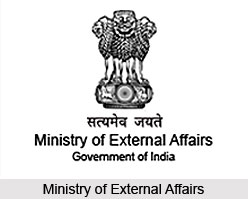Ministry of external affairs manages the foreign affairs of the country. It is headed by the external affairs minister who is given the charge of this Ministry. He represents the country and Government of India in the international forum. The minister of external affairs oversees the Indian Foreign Service (IFS). The Ministry of External affairs is run by Bureaucratic officials from the IFS headed by the Foreign Secretary. He is the top diplomat for Indian foreign relations. The Foreign secretaries are experienced IFS officers who are appointed as ambassadors to foreign nations. The work of co-ordination between the various territorial and other divisions as well as their maintenance is done by the Indian Foreign Secretary.
 The Ministry is divided in two Divisions - territorial and functional. The territorial demarcations have been demarcated according to certain geographic categorisations. Thus there are territorial divisions such as African division looking after all of the African countries, American or the AMS division which looks after the Canada and USA, the BM division which looks after Bangladesh and Myanmar, the East Asia division which looks after six countries which include the PRC, Japan, Republic of Korea (South) and Democratic People`s Republic of Korea (North) etc. It is a natural outcome that with the changing international situation, there is seen a change in the nomenclature and the number of these divisions. In addition to these various territorial divisions, there are a number of specialised divisions which are functional in nature, namely, coordination, economic, external publicity, historical, legal and treaties, passport, visa and consular, policy planning and review, protocol and the United Nations.
The Ministry is divided in two Divisions - territorial and functional. The territorial demarcations have been demarcated according to certain geographic categorisations. Thus there are territorial divisions such as African division looking after all of the African countries, American or the AMS division which looks after the Canada and USA, the BM division which looks after Bangladesh and Myanmar, the East Asia division which looks after six countries which include the PRC, Japan, Republic of Korea (South) and Democratic People`s Republic of Korea (North) etc. It is a natural outcome that with the changing international situation, there is seen a change in the nomenclature and the number of these divisions. In addition to these various territorial divisions, there are a number of specialised divisions which are functional in nature, namely, coordination, economic, external publicity, historical, legal and treaties, passport, visa and consular, policy planning and review, protocol and the United Nations.
Foreign Service Board
This organization works under the chairmanship of the Foreign Secretary. Other members of the Board are Secretary (East), Secretary (West) and Joint Secretary (Administration) in the Ministry. The Secretary in the Commerce Ministry is also a member. The Board advises the government in postings and transfers of the diplomatic officers other than those of heads of missions; all promotions and confirmation in the Indian Foreign Service or the IFS (A) up to grade IV; promotions to the senior scale of IFS (A) from IFS (B) in consultation with the Union Public Service Commission (UPSC); and grant of diplomatic status to officers posted in Indian missions abroad.
Foreign Service Training Institute
The Ministry of external Affairs has its own training arrangements for its personnel. The activities of this institute are ever increasing.
The Ministry has no attached offices. However, there are over a 100 missions abroad. The diplomatic and consular missions abroad have a unique status and cannot be described either as Attached or Subordinate offices. The Ministry does have two subordinate offices namely, the Central Passport and Emigration Organization, New Delhi and the External Affairs Hostel, New Delhi. During 1990, several innovative measures were introduced by the Consular, Passport and Visa (CPV) Division to rationalize, simplify and further streamline the functioning of the passport offices in India and the consular sections of the Indian missions abroad.
Thus discussed is a brief outline of the structure and functioning of the Ministry of External Affairs in India.




















